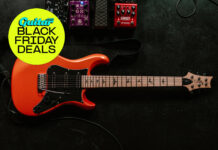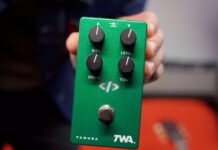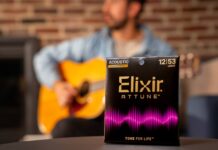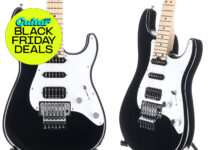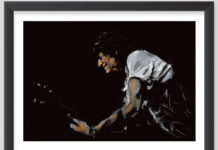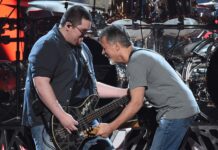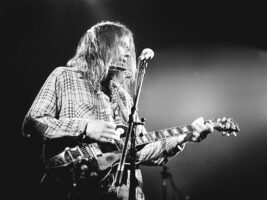
The guitar gear used by Neil Young on his Harvest album
Neil Young is not a man who does a lot of gear-focused interviews, which makes the secret of his incredible and hugely influential guitar tones something of an enigma in guitar circles. While guitar fans do our best to extrapolate what Young used, we do have the benefit of one forthright source. His longtime guitar tech Larry Cragg has been pretty open about the gear Young has used and his preferences when it comes to tone.
READ MORE: The Gear Used by Jimmy Page on Led Zeppelin’s Physical Graffiti
What we don’t really have is any concrete idea of exactly what he was using and when – so we’re left to pull from what Cragg has shared, combing the various interviews, photographic evidence from his studio and live sessions, and a fair bit of hearsay, too.
Harvest is an album that many see as the pinnacle of Young’s long and storied career. And there’s a good case for it – it’s his best-selling album, and gave him his only number one song in the US in the shape of Heart Of Gold.
The album also helped solidify his signature sound. As we know, Young has, at times, been very experimental when it comes to his guitar rig, but for most, when we think of the “Neil Young Sound” we think of Harvest.
The ‘Old Black’ Les Paul
We can’t talk about gear used on a Neil Young album without talking about his main electric guitar, Old Black. Old Black is a heavily modified 1953 Gibson Les Paul Goldtop that Young obtained from his Buffalo Springfield bandmate Jim Messina. However, regarding the recording of Harvest, there is some debate over what pickup was in the bridge position. The most reputable sources, as well as Neil Young himself, claim that the Firebird humbucker was installed in 1973, which would be after the recording of the album. It is widely believed that the pickup in the guitar during the sessions was a DeArmond Dynasonic single-coil (the neck was still a stock Gibson P-90 which had been rehoused in an aluminium cover).
Cragg stated that he installed the DeArmond which was in the guitar for about two years before being replaced by the Firebird humbucker. If the Firebird pickup was installed in 1973, then the pickup in Old Black during the recording of Harvest would have been the DeArmond.
The White Falcon
As the story goes, Young traded his first White Falcon, a 1959 model, to Stephen Stills in exchange for a rare 1960 White Falcon that had stereo outputs (though Cragg often refers to this guitar as a 1970 model). This guitar was unique, so much so that it had its own model name, the 6137 (a regular White Falcon was a 6136). It was made from 1958 to 1981, but in very small numbers.
The guitar actually had different pickups than a standard Filter’Tron; it had what historians call “Project-O-Sonic” pickups which had wiring that separated the three pole pieces on the bass of each pickup from its three pole pieces on the treble side of each pickup. Meaning that one output was for bass and the other for treble. They could be routed to two different amplifiers and panned in a recording mix. It is easy to see why Young wanted this particular White Falcon model as it was so much more versatile in the studio. This guitar was most notably used on the solo for Words (Between the Lines of Age).
Martin D-45
The main acoustic used on Harvest was a Martin D-45. That guitar was used on songs like Old Man. Young bought this guitar in 1969 as a reissue – the D-45 was originally made from 1933 until 1942. Martin wisely started making them again in 1968 and it has been a mainstay of the company’s lineup ever since.
Pre-war D-45s are quite rare and only 91 are said to have been made. Neil Young’s former bandmate Stephen Stills is said to own a 1939 model that he calls ‘Mother Maybelle’. At some point Young had his tech scallop the braces on the inside of the guitar to enhance its tonal response. To amplify the acoustic, Cragg installed two FRAP pickups (Flat Response Audio Pickups) inside the guitar. One is for the top strings, and one is for the bottom strings. In this way, they were better able to tweak the tone of the guitar to their liking.
Amps & Effects
The primary amplifier for his electric guitar work on the album was a 1959 Fender Deluxe Tweed (5E3), especially during the barn sessions at his ranch, where most of the electric tracks were recorded for Harvest. As far as we know, Neil Young is still partial to the Tweed Deluxe.
As for effects, there were very few, which is something that has become somewhat characteristic of his signature sound. There was, however, a 15 IPS (inches per second) tape slap-back on Young’s vocals for a few tracks, which is often confused for a subtle echo or delay. The other “effect” is something we had already alluded to… perhaps just as important as the gear itself was the studio where it was recorded, and Harvest was the first album to utilize a new studio that Young was in the process of building in his barn at his newly acquired thousand-acre ranch in Woodside, California, that he called Broken Arrow.
The barn where the album was recorded allowed Young and his band to play loud, allowing for the room ambience to be captured. The barn, and relatively primitive recording techniques, unlike a proper recording studio, often resulted in bleeding between tracks, which means you can hear the bass in the guitar tracks or drums in the piano tracks, etc. This makes mixing more difficult, but nonetheless was something that Young and his production crew embraced. This concept of using the room and recording techniques, essentially, as an effect, was a brilliantly simple way to record and forge his own sound. The sound was far from perfect, but it was Neil Young.
Neil Young is known as the Grungefather, and the recording techniques used on Harvest, along with the natural tube distortion of a cranked out Deluxe amp, helped to sculpt the tones that many rock musicians still chase today. Harvest remains a favorite among Neil Young fans and the mainstream at large.
The post The guitar gear used by Neil Young on his Harvest album appeared first on Guitar.com | All Things Guitar.
Source: www.guitar-bass.net

